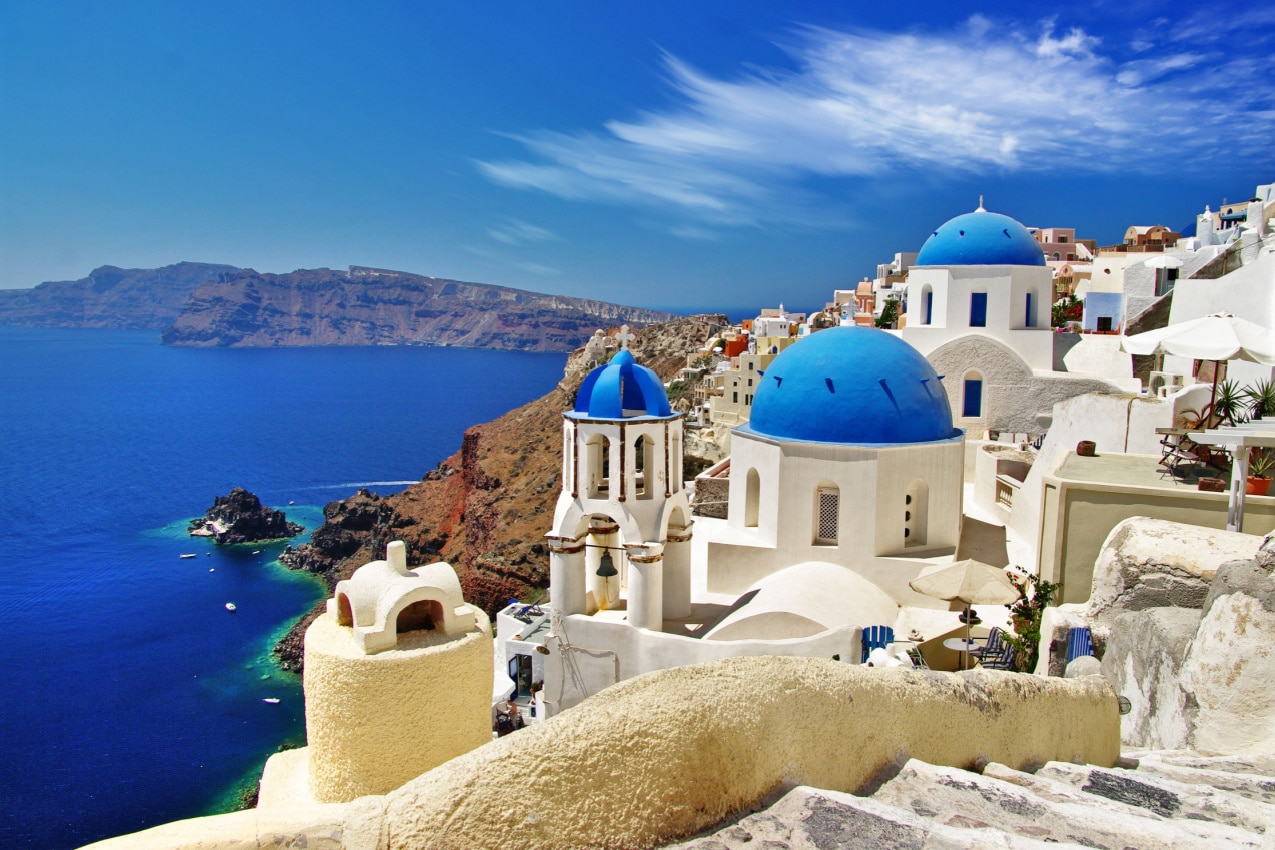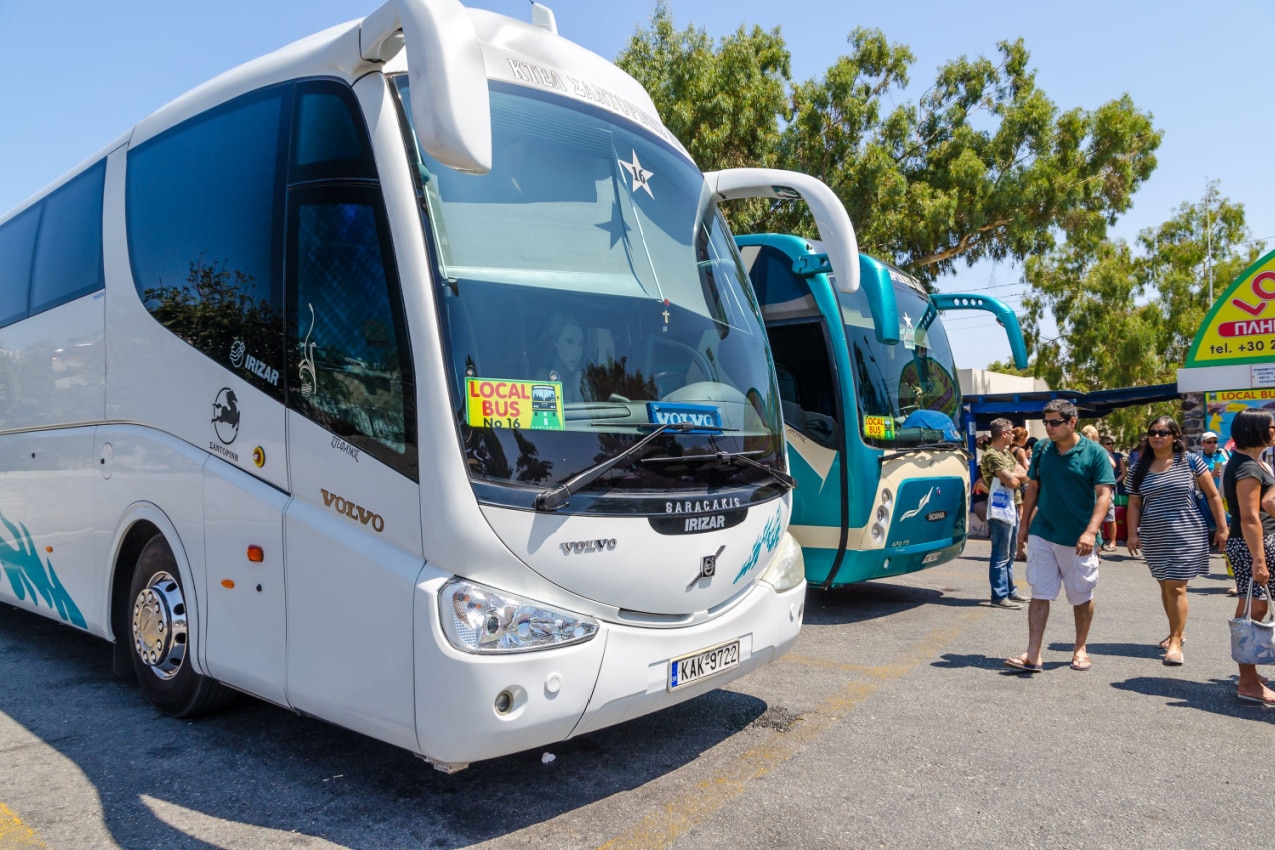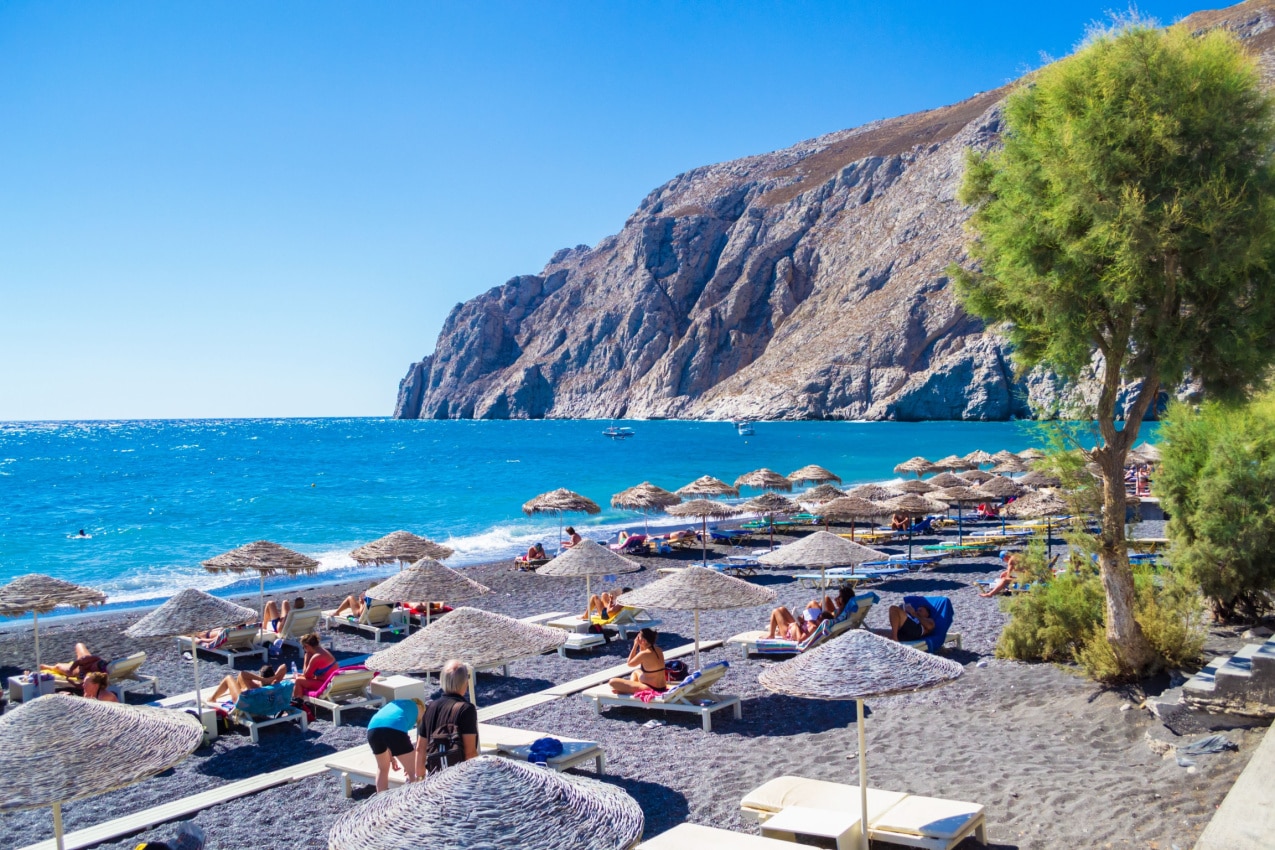With over 811,000 visitors every year, Santorini’s distinctive beauty stems from a volcanic eruption thousands of years ago, the source of its unique landscape and famous caldera.
However, looks can be misleading—so it’s wise to stay vigilant. Santorini, like any tourist haven, may pose a risk of petty theft and pickpocketing.
Of course, crime isn’t the only consideration for a safe getaway. There’s a whole checklist to get through carbon monoxide, natural disasters, tricky waves—and more.
Let’s delve into the details of staying safe in Santorini in 2024.
Are you planning a last minute trip to Santorini? We’ve put together all the resources you’ll need for a fun & safe travel:
🛌 Best & Safest Places to Stay in Santorini:
👉 Aelia Luxury Suites – Outdoor swimming pool, Bar, Free Parking
👉 Santorini Kastelli Resort – Spa and wellness centre, Family rooms, Restaurant
👉 Aqua Luxury Suites Santorini – Sea view, Daily housekeeping, Family rooms
👉 Alleys All-Suite Hotel & Spa – Airport shuttle, Outdoor swimming pool, Bar
⛱️ Fun Activities & Tours in Santorini:
👉 Santorini Classic Catamaran Cruise with Meal Drinks and Transfers
👉 Private Classic Santorini Panorama: Visit the most popular destinations!
👉 Horse Riding to Black Sandy Beach
🚗 Best & Safest Santorini Transportation Services:
👉 Airport Pickup Service – Welcome Pickups
👉 Rent a Car – DiscoverCars
🙏 Stay Safe While Travelling:
👉 Safetywing (for medical insurance)
👉 VisitorsCoverage (for trip insurance)
Is Santorini Safe?

Santorini is safe and has crime levels that are quite low. Still, stay on your toes while exploring and use some common sense. Here’s the lowdown on safety in Santorini:
- The crime rating of Santorini is very low, at 22.73.
- The most common crimes that may affect tourists are drug incidents, physical assaults, and theft.
- The public transportation on the island is extensive and reliable but requires a bit of caution to avoid getting pickpocketed.
- Taxis are the safest mode of transport, but you need to call one, as the ones parked on the street may not be licensed.
- Santorini is at a low risk of two natural disasters: volcanic eruptions and earthquakes.
- Carbon monoxide poisoning may happen in hotels and rentals that don’t have a CO detector installed, so carry a portable one.
- Beaches are safe and beautiful, but don’t walk barefoot on the black sand beaches as they tend to get really hot from the sun.
Travel Advisory for Greece
The United States travel advisory gives Greece a Level-One travel warning. This is the lightest warning reserved for countries with the lowest crime rates and minimal safety concerns. Basically, for tourists, it means exercising “normal precautions.”
Greece is categorized as a Level-One country in the Canadian travel advisory, too. But like anywhere else, the advisory warns tourists to keep an eye out for petty theft, drug-related incidents like spiking, and scams. Still, take only normal precautions to remain safe from these smaller crimes.
A Comprehensive Look at Santorini Crime Rates
Santorini boasts an impressively low crime rate of 22.73, with common offenses being drug-related incidents and theft.
Petty theft is the most common crime encountered by visitors, as confirmed by the Canadian travel advisory.
When it comes to violent crime, Santorini mirrors Greece’s overall low homicide rate, which is 0.85 incidents per 100,000 people. However, as highlighted by the Australian travel advisory, physical assaults may occur, primarily stemming from bar fights fueled by excessive alcohol consumption.
In addition to Santorini’s nightlife, large clubs also contribute to the sale and consumption of illegal narcotics. Do not purchase if offered because taking part in such a crime may not only pose safety risks but also legal consequences.
In any case, Santorini’s crime rates are significantly lower than those of several popular tourist destinations such as Paris, London, Barcelona, and Amsterdam.
| Safety Concerns | Crime Rate | Status |
| Overall Crime Level | 23.08 | Low |
| Increase in Crime (Past 3 Years) | 50 | Moderate |
| Home Break-Ins and Thefts | 21.43 | Low |
| Mugging and Robbery | 21.43 | Low |
| Car Theft | 17.86 | Very Low |
| Theft from Vehicles | 25 | Low |
| Personal Attacks | 17.86 | Very Low |
| Verbal Insults | 19.64 | Very Low |
| Racial, Ethnic, Gender, or Religious-Based Attacks | 14.29 | Very Low |
| Drug Use and Dealing | 28.57 | Low |
| Property Crimes (Vandalism and Theft) | 23.21 | Low |
| Violent Crimes (Assault and Armed Robbery) | 12.50 | Very Low |
| Corruption and Bribery | 32.69 | Low |
| Safety Walking Alone in Daylight | 87.50 | Very High |
| Safety Walking Alone at Nighttime | 75 | High |
Source: Numbeo, 2023 data
Police Presence in Santorini
The Greek police force, known as the Hellenic Police, operates throughout Greece, including the islands, and Santorini is no exception. The local police station on the island is named the “Thira Police Station.”
The Hellenic Police has several departments that deal with various situations. These include the Criminal Investigation Department, focused on investigating criminal activities, the Traffic Police for road safety, and the Coast Guard for maritime security.
In addition to these responsibilities, the police force handles emergencies and provides assistance to those in need, including both residents and tourists. So, if you ever find yourself in Santorini and require police assistance, know that the Thira Police Station and its officers are there to help.
Public Transportation Safety in Santorini

The Canadian advisory deems public transportation in Santorini safe and reliable. The bus network is extensive, ferries traverse between mainland Greece and Santorini, and all of them meet European safety standards. However, be mindful of your belongings to prevent potential pickpocketing on public transportation.
When it comes to getting around Santorini, the advisory suggests that using a taxi is one of the safest and quickest modes of transportation on the island. There is no Uber in Santorini, only local taxis that you can call at +30 22860 22555.
Santorini taxis are metered. For instance, the average cost for a 15-minute ride from Thira Airport to Fira is approximately €17 – €22 or $18 – $24. Generally, taxi fares to other parts of the island are around 30€–40€ or 32$–43$ under normal traffic conditions.
All in all, a taxi is your best option for safe transportation around the island, but a bus, train, or ferry is more affordable.
Medical Care Quality in Santorini
The healthcare system in Greece is regarded as very good, with a total of 270 hospitals as of 2019. Keep in mind that private hospitals are often considered better than public ones. Additionally, private hospitals tend to have more modern equipment compared to their public counterparts.
Public hospitals in Greece may have longer waiting times due to higher patient volumes. Moreover, the likelihood of English-speaking doctors and nurses is higher in private hospitals. However, private facilities charge higher prices for their services so you may need to consider this cost when calculating the overall budget for your vacation.
For added peace of mind, consider getting travel insurance that includes medical coverage. So, before you embark on your vacation, take a moment to review your insurance coverage and confirm which hospitals fall under its umbrella.
Is It Safe to Travel Solo in Santorini?
Once again, the island is safe and secure, with minimal criminal activity. For solo travelers, Santorini is considered a very safe destination throughout the day, but common-sense precautions are still recommended, especially at night.
If you want easy access to the nightlife in the island’s heart, it’s a good idea to book at a hotel that’s in the center so you can walk home quickly. We also recommend that you don’t go overboard with alcohol consumption so that you can retain awareness of your surroundings. All in all, the locals are friendly and inviting, so you’ll generally have a good experience traveling alone there.
Perils of Nature: The Risk of Natural Disasters in Santorini
In Santorini, the primary natural disaster risks are associated with volcanic activity and seismic events, but the risk of both is very low.
Volcanic Eruption
Santorini is a volcanic island. Its distinctive crescent shape is the result of the Minoan eruption 3,600 years ago that caused the island’s center to collapse, resulting in the famed caldera. According to the Global Volcanism Program, the last eruption occurred in 1950, which is more than 70 years ago, so it’s relieving to know just how rare these disasters are.
Despite its volcanic history, the island is considered safe for tourism. Santorini’s monitoring systems detect all potential volcanic activity, and the island is well-prepared to manage such situations.
Earthquakes
Santorini is close to where the African and Eurasian tectonic plates meet, so earthquakes are possible but are usually on the mild side.
Historically, between 1994 and 2002, Santorini experienced around 1,000 earthquakes coming from Nea Kameni and the caldera of Santorini. This timeframe is referred to as the “Crisis Period.” Still, none of the earthquakes were powerful enough to cause damage to property or locals.
That sort of frequent seismic activity hasn’t recurred in Santorini, but it’s still smart to keep an eye on earthquake trackers. Greece has seismographs and early warning systems to give you a heads-up if there’s any seismic activity. Safety first, but no need to worry about it.
Beware the Silent Threat: Carbon Monoxide Poisoning in Santorini
The good news is that Santorini has no recorded incidents from the toxic gas–carbon monoxide (CO). However, in another Greek hotspot, Corfu, there were two fatal cases. Two children were poisoned in their holiday bungalow because of a faulty water heater system.
The tricky thing about carbon monoxide is that it’s invisible and has no smell. At first, its leak might cause mild flu-like symptoms like a headache and nausea. But if you breathe it in for a long time, especially when you’re asleep and the gas is leaking, it can have serious consequences, even fatal ones. When inhaled, carbon monoxide stops the blood from carrying oxygen to cells and tissues, potentially causing paralysis, brain damage, or loss of life.
For your safety, we highly recommend getting a portable CO detector for your travels. You can put it in your hotel room and it’ll notify you if there’s a faulty gas leak in the air you’re breathing. While hotel rooms and rentals in Santorini may already have CO detectors, it’s a good idea to bring your own, just to be sure.
Serenity by the Shore: The Safety of Santorini Beaches

The Canadian government’s travel advisory highlights that most beaches in Greece, including those in Santorini, are supervised and have excellent safety procedures in place.
It’s still wise not to swim when there are strong winds and a wavy sea. Also, watch out for corals, urchins, and jellyfish, as they might sting or cause an infection if you touch or step on them.
The black sand beaches made of volcanic pebbles can get really hot under the sun, so when you go to the beach, resist the urge to walk barefoot. This includes the famous Perissa Beach, Kamari, and Monolithos Beach. So, keep those flip-flops at hand!
Santorini Weather Patterns: What to Expect
Santorini’s summers are hot and sunny, lasting from June to September. The average daily high temperature is above 80°F (26.6°C). July is the hottest month, with the highest temperature going up to 85°F (29.4°C).
Winter is colder and lasts from December to March–as in most areas with four-season climates. The average daily high temperature is around 63°F (17.2°C) during this period. February is the coldest month, with the lowest temperature reaching 49°F (9.4°C) and the highest reaching 58°F (14.4°C).
Santorini is cloud-free from the end of May to October. July is the clearest month, perfect for getting that golden tan–and even when it’s hot, it’s manageable. On the flip side, December is the cloudiest, with clouds covering the sky about 38% of the time.
Rainfall is rare in Santorini from May to the end of September. The driest and sunniest month is July, with an average rainfall of 0.0 inches (0mm). On the flip side, December, the cloudiest month, sees a bit more rain, with an average of 2.7 inches (68.58mm).
Monthly Average Temperatures in Santorini
| Month | Fahrenheit (°F) | Celsius (°C) |
| January | 54 | 12.2 |
| February | 54 | 12.2 |
| March | 57 | 13.8 |
| April | 61 | 16.1 |
| May | 68 | 20 |
| June | 76 | 24.4 |
| July | 79 | 26.1 |
| August | 79 | 26.1 |
| September | 75 | 23.8 |
| October | 68 | 20 |
| November | 62 | 16.6 |
| December | 57 | 13.8 |
When Is the Best Time to Visit Santorini?
The best time to pack your bags and head to Santorini is during the shoulder season—late April to early June and September to early November. The weather is warm, sunny, and clear, and you can grab good deals on hotels and airfare.
If you’re into a more laid-back vibe and don’t mind cooler temperatures, consider visiting Santorini during the off-season—from late November to March. Some places might have reduced hours, but you’ll get a taste of a quieter side of the island. Bonus: this is the cheapest time for hotels, tours, and flights.
The peak season in Santorini, from July to August, is pure magic. It’s when the weather is at its absolute best, and the whole island comes alive. If you’re all about that summer adventure, with sunny days, vibrant streets, and lively beaches, then the peak season is perfect for you. Keep in mind that prices during the peak of summer are higher.
How to Stay Safe in Santorini
- Thieves might be lurking at tourist hotspots, restaurants, public transport, and beaches. Keep a close eye on your belongings
- Guard your drink. Criminals might try to spike it with drugs
- Locals might offer you a donkey ride. Politely decline
- Summers in Santorini are hot! Protect yourself with sunscreen and a hat, and stay hydrated
- When someone else is handling your cards, keep a close eye. Withdraw money from ATMs in malls or inside banks
- Stay up-to-date on media reports regarding any potential terrorism threats in Greece, as well as volcanic activity or earthquakes around Santorini
- If you’re steering a boat, know your boat’s weight capacity and don’t exceed it
- If you’re headed to the famous Red Beach, be aware of the potential danger of rockslides
Emergency Numbers
- Emergency: 112
- Police:100
- Ambulance: 166
- Fire Department: 199
Farewell to Paradise
With these tips, your Santorini adventure will be nothing short of amazing and secure!
Remember, theft is the most common crime that may affect tourists, so while you’re basking in the sun, please don’t leave your valuables unattended. The same caution applies when you’re exploring charming streets, driving on public transport, or savoring a delicious meal in a restaurant.
So, rest assured, Santorini is a safe haven for travelers. But, as with any destination, good old common sense goes a long way! Safe travels.